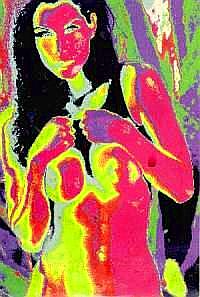
(PART 1:)
[Introduction]
[Sculpture]
[Installations]
[PART 2:]
[Concepts]
[Resources]
[Jno Cook]
[Credits]
[PART 3:]
[Code Sources]
[The Boxes]

 Part 1 of the on-line catalog for an exhibition
of computers, computer graphics, screen manipulations, installations,
sculptures, and sound, titled NO CARRIER, by Jno Cook, dealing with the
incursion of computers into our jobs and homes and the effect of the
internet, at Beret International gallery in Chicago, 1550 N Milwaukee,
Chicago Il 60622 (phone: 773 489 6518), one of the
[Uncomfortable Spaces] galleries, From September 6
through October 12, 1996, with an introduction by Amber Baum.
Part 1 of the on-line catalog for an exhibition
of computers, computer graphics, screen manipulations, installations,
sculptures, and sound, titled NO CARRIER, by Jno Cook, dealing with the
incursion of computers into our jobs and homes and the effect of the
internet, at Beret International gallery in Chicago, 1550 N Milwaukee,
Chicago Il 60622 (phone: 773 489 6518), one of the
[Uncomfortable Spaces] galleries, From September 6
through October 12, 1996, with an introduction by Amber Baum.
"Let's see what we have..."
-- Aristotle, ca 400 BC
I recently saw a cartoon in the Tribune where it was suggested that an appropriate action for some computer situation was to hit the French Fry key and Delete. This is a joke, of course. But jokes depend on a commonly held base of knowledge and acceptable behavior. I don't have a French Fry key. Nor do 95 percent of the computer users in the world. What is happening here?
NO CARRIER represents that moment when you disconnect from net infinity, and push back your chair to take an overview. It's not really the living organism it seemed to be. It is only a bunch of machines and telephone wires. It's not really there, is it?
-- It tells me when I have mail, "You have mail."
-- I even bought flowers for my mother.
The digital computer, in being able to simulate just about anything, is a chameleon which fits in anywhere. It has compromised our thinking and will alter our outlook on the future and the past. But by some exterior design the computer and internet communication are shrouded in mystery and designed for opacity. Some would say, It is just a tool.
But what kind of tool is this? I would like to take a more radical look at what we have. It is time to take stock of the materials, to suggest that computer art is not just pictures made with computers, but might includes other aspects: the power of programming, the materials and machinery, and the connections (real or not) to other computers. There is more at stake here.
The only art is in the program.
-- Judson Rosebush
I have divided this exhibition into four dimensions.
 When I asked Amber Baum if she would write an
introduction for this catalogue, she responded piecemeal with email then
finished it with a lengthy explication on computers and art. Her last
comments follow below. /jno
When I asked Amber Baum if she would write an
introduction for this catalogue, she responded piecemeal with email then
finished it with a lengthy explication on computers and art. Her last
comments follow below. /jno
Date: Too Late
From: Amber
To: Jno, Unknown Others
Subject: Idea BytesAnd if Man Ray was right (go back and reread, there's a good patron), what better medium for art than computers, which as we have all suspected for years, are not about anything but themselves? Without computers no computers would be necessary. Like washing machines and fabric softener. Convenience upon convenience upon convenience making Lives (TM) a well-scrubbed, better-organized needle in the software haystack.
At first I tried to write this on my computer. I sat down and created a file called intro and stared and started and stared and erased a few bad lines and then gave it up and ignored it for a while. I could not do it because I had forgotten the relevance of what I had been wanting to say. You may have grasped it in the email correspondence up there (Fri, 5 Jul 1996), or maybe not--that was a lot of useless-to-you-but- maybe-useful-to-someone-else text to sift through (...and if that's not a metaphor for the web...). Anyway, you are getting impatient: what had I been wanting to say? This: that every medium has its place, its relevance, even every story has its own most-appropriate way of being told. Yes, yes, Amber, Art-School 101 -- *yawn* Wait! Don't turn the page yet!!
What I mean to say, Dear Reader, and what Jno means to say, is that "computer art" is NOT. Photoshop is a pharse. CD-YAWN. The Web is more than electronic magazine. Wired still has columns, features, ads, and a table of contents. Art is NOT the province of the rich or of the digiterati. (Well ok, they can have some, but the brats are notorious for not liking to share.) How, oh how, have expensive tools ("Must .. have .. Pentium Pro!") fooled so many? Haven't we learned these lessons again and again, that what glitters is bullshit? Just because computers are tools does not make their products art. Is every chair a work of art if made with a really nice hammer?
For the third time I opine: Computers, like other media, are either tools or art in and of themselves. Jno Cook is sick of those who would frame the nail for being the victim of the ivory-inlaid hammer. He finds the art in and of the computer itself. The "in" is easy enough to see (hint: big and green). The "of" is invisible -- it's the programs which drive the smiley faces and dum dee dum and the swearing. (May these words sink in someday: good programmers belong alongside poets and master engineers for the work they do. These days, they stand alongside teachers for the recognition they get).
It never ceases to amaze me that I am not yet twenty and so many patterns of human behavior are yesterday's news. Whenever a new medium comes along, there are those who claim that it will change absolutely everything, and yet for years it is almost exclusively used as the already-existing media are (photography, radio, television, film...computers...) until one or many people force a breakthrough, until someone or ones in the right place or places uses or use the medium in a new way.
There is also the faction that is frightened to death of what the medium will do to people and their relationships with God, each other... I use as an example a student in one of my classes last year. We were having a discussion about netsex (like phone sex but more difficult, because you have to type), and we were not understanding each other at all. Then I realized the question that was in his mind, and I pointedly said (no, patience with ignoramuses has never been a virtue) "It's important to remember that those who engage in netsex would _prefer_ to have real sex, with a real person, than to type it out with a stranger. It's used as a surrogate." Yes, I _actually_ needed to make this point. If humans really had the ability to invent technologies and objects and subcultures that had such anti-biological power, the Republicans would be in MUCH better shape. (John Wayne would return from the dead to say of Ralph Reed, "Truly, he wuz the Sun of Gawd!")
For that po-mo touch I should add that I haven't seen a bit of the show yet. I find that funny and completely appropriate. I love the dolls (Thu, 20 Jun 1996); I think they're my favorite. I undoubtedly will love the show.
-- Amber Baum
Apologies to Jno, Cecil Adams, Tiffany Hanulec, David Feldman, and the WWWAC List, for stealing some ideas and turns of phrase. Thanks and apologies to Jno for not getting _so_ angry at me and my procrastination. Plain old thanks to Sarah Hacker and Amy Benson.
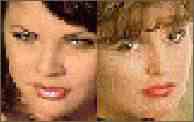
The images are areas of women's faces from Usenet porn, reduced first to 40 by 50 pixels, then printed to 8x10 inches, so that the pixels are about 1/4 inch square. They are printed in 9-pin ribbon color on acid-free paper. Convergence happens at a distance; at close range the faces break up into almost unreadable blocks, the fingerprints of image files to be found on computers throughout the world.
These images, and thousands like them, float on and off the Usenet. The average daily postings to the alt.binary.erotic groups amounts to 1100 files per day -- probably 300,000 to 350,000 new files per year. The average stay is 2 or 4 days before they disappear from public view, to reappear at unpredictable intervals in the future as in the past.
If this romanticizes the subject, think of it instead as representing only part of the story. These images are a metaphor for the imaginary ideographic life which has already been attributed to the internet in works of fiction by William Gibson and others: virtual, fugitive, and anarchistic. There are no rules. There is no order. Absolute anarchy rules the internet. Without an understanding of the net's anarchistic basis, there is no understanding the net.
See also a separate [faces] page at this site.
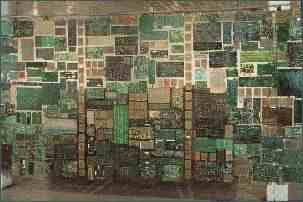
The metonymy of this piece should be obvious, at least it is to me. The Federal Government has warehouses full of magnetic records which cannot be read because of the lack of reading equipment, and because only a single degraded bit among the media is enough to render all of it totally opaque. But the fugitive basis of magnetic material is not the only problem.
As the internet is turned into the entertainment-net by commercial enterprises the intellectual level of information is dropping to what will be universally comprehensible by 8-year olds. All things will be current, and ahistorical, for only the new will have value. Junior will research Dyne-o-Saurs on A-o-L, because there is no other source. What I see is a curtain drawn across the face of time. It is like the descent of another dark age, where future generations will have to rediscover what happened before the twenty-first century, and wonder at the intervening history.
Among comments on Sven Birkets' book "The Gutenberg Elegies," the following from Professor of CS Christian Kock, at Oberlin College...
Internet reality is presenting a truth cut off
from a history and from a continuing context of
meaning. All truth is surface truth.
Around the Square, Summer 1996,
Oberlin College, OH

The future is represented by one hundred and sixty doll heads in assorted household jars (Mayo, Peanut Butter, Fruit juice), and connected to each other with 450 feet of clear plastic tubing, two or three connections from the lid of each jar. All the lids, of course, are beige. On the floor.
This is representational of the whole of the internet, an organic comedy of connectivety, and conservatively a mirror of the future, when everyone will be connected. It reiterates the net's anarchy at the physical level. I have added two honking, angry, confused computers, titled "On Line."
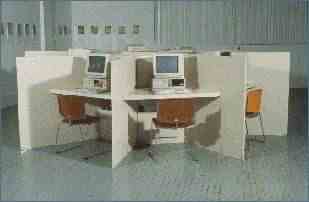
Ironically, most computers are idle 99 percent of the time. At this merry-go-round installation of 8 computers, however, the machinery is actually very busy, with each computer doing something -- something simple or stupid, or creatively wasting time, or producing items of questionable value. They comment on their ability to replicate endlessly, to mimic, or to put forth a programmer's attitudes. Only one is interactive.
The 8 machines attempt to play out the chameleon nature of computers by presenting aspects of order, randomness, iteration, and overhead -- without suggesting resolution. I have mainly selected programs which *could* be accomplished with junk computers, and have attempted to reflect the types of inane, improbable, and inglorious uses which the machinery could or might be used for. Corollary to the principal of the Turing Machine, it would go without saying that *any* of the 8 programs can be run by *any* of the 8 computers.
Images precede ideas, and my ideas do indeed come from images, to flow directly back to images, but I will simply point out the intermediate IDEAS or CONCEPTS as appropriate, as if they form a rational foundation to what I am presenting. If you cannot follow the four parts of the preceding sentence, then just skip down and look at pictures.
The boxes are all intel 086 class processors, ranging from 088 through low end 386. Video output includes MDA, XMDA, Hercules, CGA, EGA, and TTL monitors - and one B/W VGA. The programs are all DOS based utilities run from batch files and some BASIC programs. No Windows, no Soundblaster cards, no high end graphics, no VGA, no need for RAM over 1 meg. All of the code and utility programs used to run the 14 computers fits in half the space of a single floppy disk. Jibes at hi-tech overhead are fully intended.
The utility programs represent the legacy of individual efforts freely
distributed around the world over the last two decades. There is a DOS based
"freeby" or "shareware" program which will do just about anything,
contributions of some estimated 40,000 individuals. It represents also an
era which is closing for DOS and Windows users, although it continues at a
much larger scale (as it has for thirty years) at Un*x platforms.
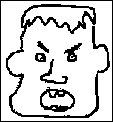
 The IDEA is of an impolite talking computer
- the very opposite of the businesslike female voice of Star Trek's
computer. There is a similar brain dysfunction among humans, persons unable
to string together grammatically correct sentences, but able to swear like
troopers.
The IDEA is of an impolite talking computer
- the very opposite of the businesslike female voice of Star Trek's
computer. There is a similar brain dysfunction among humans, persons unable
to string together grammatically correct sentences, but able to swear like
troopers.
Draws a face on the screen, and scrolls randomly made-up cuss phrases across the bottom. The mouth is redrawn with each vowel, and closed between phrases. There are five mouth designs, assigned randomly to vowels. The phrases are be sounded out through the PC speaker, but amplified.
The curses are made up from a selection of 219 nouns and 676 adjectives made into phrases of the form, YOU, ADJECTIVE, ADJECTIVE,.. NOUN! Each phrase may have up to five random adjectives. The word list was selected from a 35,000 word spelling dictionary, and edited to remove sexist, ageist, and homophobic references, and slurs on physical handicaps. This still left a large vocabulary which attacks dirt and stupidity. There are a few hundred billion disgusting phrases before the computer starts to be seriously limited in creative combinations. Random, endless.
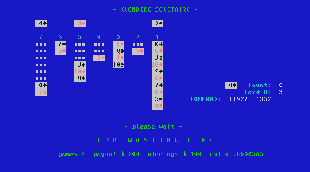
I watched myself play for months, and developed rules for which cards to move first, what to check for second, and so on. However, it is just as likely that any series of random moves would do as well. The current version does just that, it simply attempts to move cards randomly. The program checks to see if any attempted move is legal, relocates the cards, and keeps score. Up to 32,000 moves are attempted per game. The next game is dealt if nothing happens in 2000 random moves. Never stops.
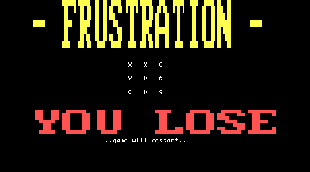
 An update of an unbeatable tic-tac-toe
program written and floated into freeware space a number of years ago. The
IDEA and CONCEPT is of a computer being absolutely obnoxious about its
big-deal virtuosity. This newly rewired version of the Tic Tac Toe game
invites you to play, plays and scores in bold graphics and big and flashing
letters, and in general behaves triumphantly obnoxiously, and talks at you
too. An interactive program running on an XT at 2 megahertz, and in color.
Repeats invitations to play at 30 second intervals.
An update of an unbeatable tic-tac-toe
program written and floated into freeware space a number of years ago. The
IDEA and CONCEPT is of a computer being absolutely obnoxious about its
big-deal virtuosity. This newly rewired version of the Tic Tac Toe game
invites you to play, plays and scores in bold graphics and big and flashing
letters, and in general behaves triumphantly obnoxiously, and talks at you
too. An interactive program running on an XT at 2 megahertz, and in color.
Repeats invitations to play at 30 second intervals.

 An "Angry Fruit Salad" is a bad
visual-interface design that uses too many colors (see the on-line Jargon
File, elsewhere). I have seen the effect often enough when switching images
in Photoshop and other graphics aps. The CONCEPT is of a permanent graphical
disability applied to the endless garbage coming off the Usenet.
An "Angry Fruit Salad" is a bad
visual-interface design that uses too many colors (see the on-line Jargon
File, elsewhere). I have seen the effect often enough when switching images
in Photoshop and other graphics aps. The CONCEPT is of a permanent graphical
disability applied to the endless garbage coming off the Usenet.
This is a showing of 400 Gif files -- erotic images downloaded from the Usenet, about a third of one day's new files -- using a 'broken' graphics file viewer and an TTL monitor in 8-bit mode. Many files are arbitrarily rescaled to 1:1.33 landscape format, or sized up, no matter what the original size or aspect ratio. Distortion is not an issue here, since most images end up looking like the effects of cubism or modernism on painting anyway. This machine also runs carnival music in the background for the carrousel. 57 minutes.
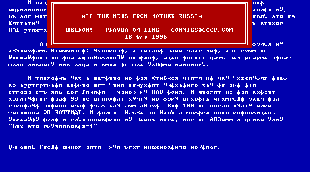
This presents all the news from Russia on an ongoing basis. Cyrillic script scrolls up endlessly. I'm connecting with the Russian language version rather than the English language edition. Sorry about that. Brought to you via Commies at cccp.com. The windowed graphics are phony too. On August 20, 1996, Pravda, the world's largest circulation newspaper, went out of business. Intercuts with Klok (See Rollo Dog). About 7 minutes.
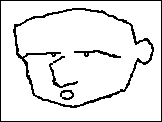
 The CONCEPT is of a computer just humming
to itself, sort of like doodling.
The CONCEPT is of a computer just humming
to itself, sort of like doodling.
Dumdeedum is an endlessly repeating binary series, where the second half of any part of the series repeats the first half with the ones and zeros interchanged. The series never repeats, yet it constantly recalls prior sections in smaller and larger parts. It thus has familiarity and rhythm, that is, it *seems* to have melody and beat.
Substitutions can be made, for example, dee for 0 and dum for 1, so that the file becomes ...
dee dum dum dee dum dee dee dum dum dee dee dum dee dum dum dee dum dee dee dum dee dum dum dee dee dum dum dee dum dee dee dum dum dee dee dum dee dum dum dee dee dum dum dee dum dee dee dum dee ... etc
Although there are never more than two zeroes or ones in a row, we hear trains of four to eight beats as a repeating pattern with variations. It starts to sound like music or poetry. The first three stanzas of the infinite file are sounded out. Simon Sygielski's Bubba face mouths the first lines. Intercut with Klok.
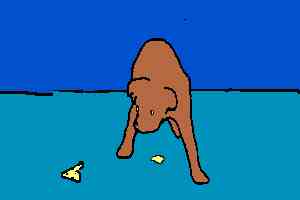 ,
,
 I know the overhead involved in activating
MOV files, and the hardware requirements, just to show "duh" quality clips.
The idea was to produce a movie using an 1983 file viewer, hand drawing each
frame, and running this without Windows, cached disk reads, 90 mHz Pentiums,
Accelerator Cards, or Tseng video cards.
I know the overhead involved in activating
MOV files, and the hardware requirements, just to show "duh" quality clips.
The idea was to produce a movie using an 1983 file viewer, hand drawing each
frame, and running this without Windows, cached disk reads, 90 mHz Pentiums,
Accelerator Cards, or Tseng video cards.
Small color PCX files; originally 4 seconds of film of a puppy (Zita Sir Puppy) playing with a piece of cardboard, previously presented as 16mm film and as rotoscoped images. These are written to the screen at a rate of 5 frames per second, constituting a small movie -- yet slow enough to make sense out of most of the movements of the puppy. Runs for 20 seconds and repeats, during which time a tune is also played. Alternates with "Klok."
Klok is a circular clock with moving hands (including a red second hand) which fills most of the screen. Black background. Nothing else. Program by others. Klok is the *only* useful screen-saver I have ever seen.
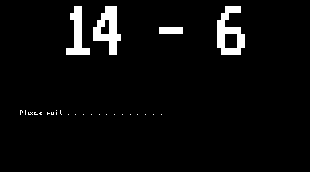
You cannot type a simple questions like, "What is three plus four?" and expect to get an answer. Computers cannot compute, except when mimicking a machine like a calculator. This machine, however, *does* compute, and with a self-important flourish. The machine finds sums and differences of small numbers, and does multiplication. The results are generally - but not always - correct. The failures are called "rounding errors." Random, never stops.
Scrolls welcome messages across the screen of a PS/2 which is placed on its side. Like an ad-sign used for a bank. In large white letters on black, with some letters made up of smaller dots or oh's. Gives the time periodically, in classical format, "The time is now..," and public service messages, "Please drive carefully."
Allows visitors to enter their name and address in guest book form. Each one-line entry, when completed with a CR, adds to a file which scrolls to the screen, and asks for the next entry. Entering the word 'scroll' scrolls the file slowly past the screen.
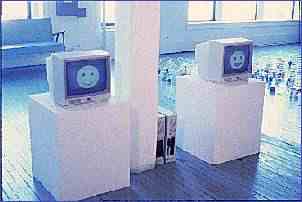
Consists of two monitors with smiley faces, which honk and randomly generated comments about net traffic. The dialogue is from typical 12-year old newbies on the Usenet. "Me too, me too." "Where's the warez." "Hurry up." Mouths open to talk. The words are written at the top of the screen. Random, infinite.
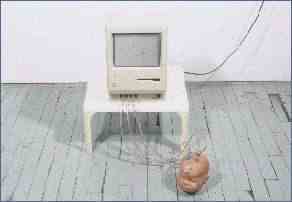
![[]](./bin/ylinux.gif)